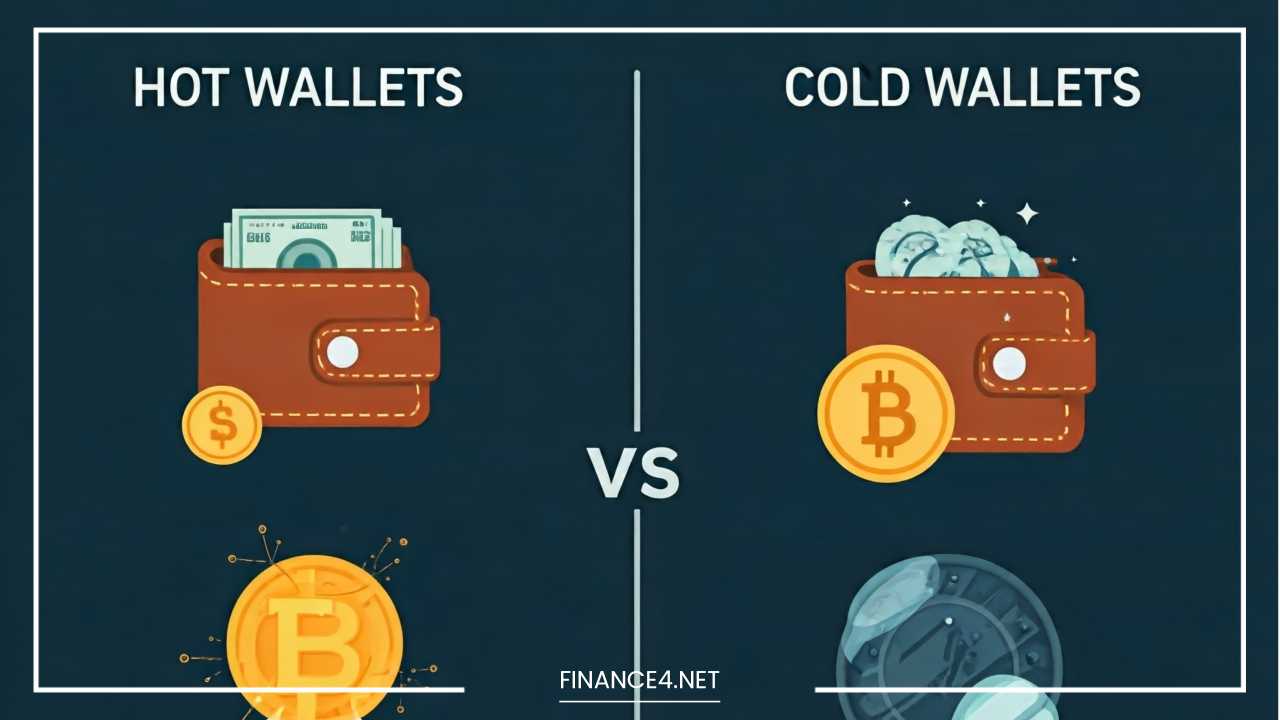Hot Wallet vs. Cold Wallet: What’s the Difference?

Hot Wallet vs. Cold Wallet
Hot Wallet vs. Cold Wallet: What’s the Difference?
In the burgeoning world of cryptocurrency, safeguarding your digital assets is of utmost importance. With the increasing popularity of digital currencies like Bitcoin, Ethereum, and countless others, secure storage has become a critical consideration for investors and users alike.
To this end, two primary methods of storing cryptocurrencies have emerged: hot wallets and cold wallets. While both types of wallets serve the fundamental purpose of storing cryptocurrencies, they differ markedly in terms of security, accessibility, and usability.
This comprehensive guide will delve into the distinctions between hot and cold wallets, providing you with the necessary insights to make an informed decision on which type best suits your needs.
Understanding Hot Wallets
A hot wallet is a type of digital wallet that remains connected to the internet. This constant connectivity is what makes hot wallets highly accessible and convenient for frequent transactions.
They are typically used for day-to-day cryptocurrency activities such as trading, sending, and receiving digital assets. However, the very feature that provides easy access also introduces potential vulnerabilities.
Key Features and Characteristics of Hot Wallets
- Accessibility: Hot wallets are designed with accessibility in mind. Their constant internet connection allows users to quickly access their funds from anywhere in the world. This is particularly useful for active traders or those who need to make transactions on the fly.
- Convenience: The user interfaces of hot wallets are generally intuitive and straightforward, providing a seamless experience for managing your digital assets. Features such as transaction history, address books, and integration with various cryptocurrency exchanges enhance the overall convenience.
- Vulnerability: Despite their convenience, hot wallets are vulnerable to online threats. Their connection to the internet exposes them to risks such as hacking, phishing attacks, malware, and other cybersecurity threats. It is crucial for users to employ strong security measures, including two-factor authentication (2FA), strong passwords, and regular software updates, to mitigate these risks.
- Types of Hot Wallets:
- Software Wallets: These are applications or programs installed on your computer or smartphone. Examples include Mycelium, Electrum, and Exodus. Software wallets offer a balance between security and usability but are still exposed to potential online threats.
- Web Wallets: Web wallets are accessed through a web browser and are often provided by cryptocurrency exchanges or dedicated wallet services. Examples include Coinbase and Binance. While web wallets offer excellent accessibility, they are generally considered less secure due to their continuous online presence.
- Mobile Wallets: Mobile wallets are specifically designed for smartphones and offer on-the-go access to your digital assets. Examples include Trust Wallet and Atomic Wallet. Mobile wallets are convenient but are subject to risks associated with mobile devices, such as theft or loss of the device.
Advantages and Disadvantages of Hot Wallets
Advantages:
- Ease of Use: Hot wallets provide a user-friendly interface, making them accessible even for beginners.
- Instant Transactions: Users can execute transactions quickly and easily, which is advantageous for frequent traders or those needing rapid access to funds.
- Integration with Exchanges: Many hot wallets integrate seamlessly with cryptocurrency exchanges, facilitating easy trading and management of assets.
Disadvantages:
- Security Risks: The constant internet connection exposes hot wallets to various online threats, making them less secure compared to cold wallets.
- Vulnerability to Theft: Since hot wallets are connected to the internet, they are more susceptible to hacking and phishing attacks.
- Device Dependence: Hot wallets are dependent on the security of the device they are installed on. If the device is compromised, so is the wallet.
Understanding Cold Wallets
In contrast, cold wallets operate completely offline, providing a more secure method of storing cryptocurrencies.
Cold wallets are designed to keep private keys and cryptocurrency balances isolated from the internet, thus minimizing exposure to online threats. This makes cold wallets the preferred choice for long-term storage and large holdings.
Key Features and Characteristics of Cold Wallets
- Security: The primary advantage of cold wallets is their enhanced security. By being offline, cold wallets are immune to online hacking attempts, malware, and phishing attacks. This level of security makes them ideal for users who prioritize protecting their assets from cyber threats.
- Isolation: Cold wallets remain completely disconnected from the internet, which means they are not vulnerable to the same risks as hot wallets. This isolation helps protect the stored cryptocurrencies from unauthorized access and online threats.
- Complexity: Cold wallets often require more technical knowledge to set up and use compared to hot wallets. Users need to manage physical devices or printouts and follow specific procedures for transactions. However, the added complexity is generally justified by the superior security they offer.
- Types of Cold Wallets:
- Hardware Wallets: These are physical devices specifically designed to store private keys offline. Examples include Ledger Nano S, Ledger Nano X, and Trezor. Hardware wallets typically offer additional security features such as PIN codes and recovery seed phrases to protect against loss or theft.
- Paper Wallets: Paper wallets involve printing private keys and cryptocurrency addresses on physical paper. While they provide excellent security from online threats, they are vulnerable to physical damage or loss. It is essential to store paper wallets in a safe and secure location to avoid potential risks.
Advantages and Disadvantages of Cold Wallets
Advantages:
- Enhanced Security: Cold wallets offer superior protection against online threats due to their offline nature.
- Immunity to Cyber Attacks: The lack of internet connectivity means cold wallets are not susceptible to hacking, malware, or phishing attacks.
- Long-Term Storage: Cold wallets are ideal for storing large amounts of cryptocurrency over an extended period, as they provide a high level of security.
Disadvantages:
- Less Convenient: Cold wallets are less convenient for frequent transactions due to their offline status. Users need to connect the device to a computer or manually handle paper wallets for transactions.
- Higher Cost: Hardware cold wallets can be more expensive compared to free or low-cost hot wallets.
- Technical Knowledge Required: Setting up and using cold wallets may require more technical expertise, which can be a barrier for some users.
Comparing Hot and Cold Wallets
To provide a clearer understanding, let’s compare hot and cold wallets across several key features:
| Feature | Hot Wallet | Cold Wallet |
|---|---|---|
| Accessibility | High – Always connected to the internet | Low – Completely offline |
| Convenience | High – Easy to use for daily transactions | Low – Less convenient for frequent access |
| Security | Low – Vulnerable to online threats | High – Immune to online attacks |
| Vulnerability | High – Prone to hacking and malware | Low – Protected from cyber threats |
| Cost | Free or low-cost | Can be more expensive |
| Use Case | Daily transactions | Long-term storage |
Factors to Consider When Choosing a Wallet
When deciding between a hot wallet and a cold wallet, consider the following factors tailored to your specific needs:
- Security: If you prioritize the utmost security for your cryptocurrency holdings, a cold wallet is the better choice. Its offline nature provides superior protection against online threats and unauthorized access. For users with substantial holdings or those who are particularly security-conscious, a cold wallet offers peace of mind.
- Accessibility: If you require frequent access to your funds for daily transactions, a hot wallet offers the convenience and ease of use needed for active management. Hot wallets are ideal for users who engage in regular trading or need to access their assets quickly and easily.
- Technical Proficiency: Cold wallets often require more technical knowledge to set up and operate. If you are less familiar with technology or prefer a simpler solution, a hot wallet may be more appropriate. On the other hand, if you are comfortable with technical setups and value security, a cold wallet is worth considering.
- Budget: Hot wallets are generally free or come at a low cost, making them an economical choice for users with limited budgets. In contrast, hardware cold wallets can be more expensive. Weigh the cost of a hardware wallet against its security benefits to determine if it fits within your budget.
- Amount of Crypto: For users holding a large amount of cryptocurrency, a cold wallet provides added security and is suitable for long-term storage. If you hold only a small amount of cryptocurrency or use your assets frequently, a hot wallet may be sufficient.
Balancing Security and Accessibility: Hybrid Approaches
Many users find that using a combination of hot and cold wallets offers the best of both worlds. This hybrid approach allows you to strike a balance between security and convenience, catering to various needs:
- Long-Term Storage: Store the majority of your cryptocurrency holdings in a cold wallet. This setup ensures that your assets are protected from online threats and can be securely held for extended periods.
- Daily Transactions: Use a hot wallet for smaller amounts and frequent transactions. This allows you to manage and access your funds with ease while keeping only a small portion of your assets online.
By adopting a hybrid approach, you can maximize security for your long-term holdings while maintaining convenient access for everyday transactions.
Additional Considerations
When selecting a wallet, keep the following additional factors in mind:
- Backup and Recovery: Regardless of whether you choose a hot or cold wallet, having a reliable backup and recovery plan is crucial. Ensure that you have secure backups of your private keys and recovery phrases. This will enable you to recover your funds in case of hardware failure, loss, or other issues. Follow the backup and recovery procedures provided by your wallet provider to safeguard your assets.
- Customer Support: Opt for a wallet provider with strong customer support. In case you encounter technical issues or need assistance, responsive customer service can be invaluable. Look for wallet providers that offer clear support channels, comprehensive documentation, and prompt assistance.
- Compatibility: Ensure that the wallet you choose is compatible with the cryptocurrencies you own or plan to acquire. Some wallets support a wide range of digital assets, while others may be more limited. Verify compatibility to avoid potential issues with managing your assets.
- Regulatory Compliance: Consider the regulatory environment in your jurisdiction when choosing a wallet. Some regions have specific regulations regarding cryptocurrency storage and transactions. Ensure that the wallet provider you select complies with relevant regulations and has a clear stance on legal and compliance issues.
- User Reviews and Reputation: Research user reviews and the reputation of the wallet provider before making a decision. Positive reviews and a solid reputation can provide insights into the reliability and trustworthiness of the wallet. Look for feedback from other users regarding security, ease of use, and customer support.
- Usability Features: Evaluate additional usability features offered by the wallet. These may include multi-signature support, integration with other financial tools, and advanced security options. Features that enhance usability and security can significantly impact your overall experience with the wallet.
Final Thoughts
The decision between a hot wallet and a cold wallet ultimately hinges on your individual needs, preferences, and risk tolerance.
If security is your primary concern and you are storing a substantial amount of cryptocurrency, a cold wallet provides superior protection against online threats. Its offline nature ensures that your assets remain secure from cyber attacks and unauthorized access.
On the other hand, if convenience and accessibility are more important to you, a hot wallet offers the ease of use needed for frequent transactions. Hot wallets are ideal for active traders and users who need immediate access to their digital assets.
By carefully considering the factors discussed in this guide, you can make an informed decision and select the wallet that best aligns with your needs.
Whether you opt for the enhanced security of a cold wallet or the accessibility of a hot wallet, understanding the differences and implications of each type will help you effectively protect and manage your cryptocurrency investments.



